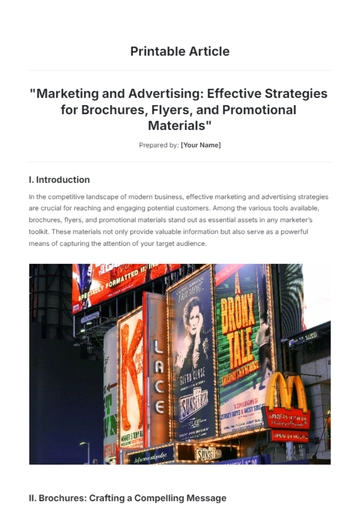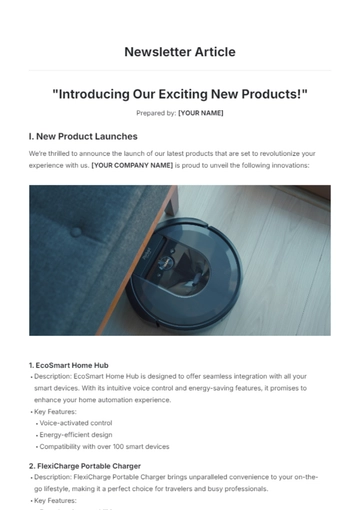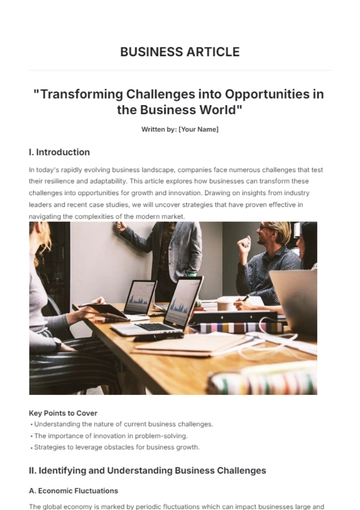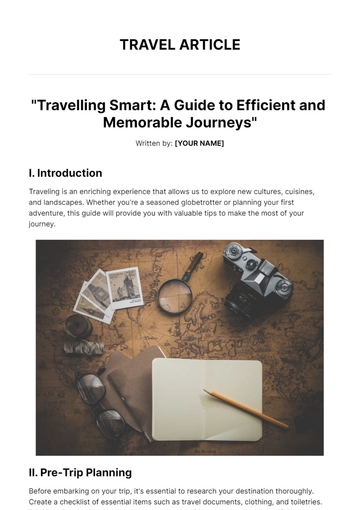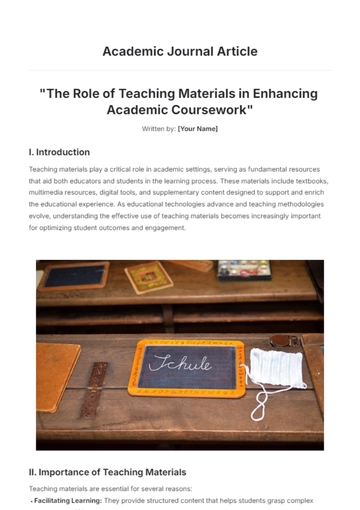Free Business Company Article

"Navigating the Path to Success for Your Business"
Prepared by: [Your Name]
I. Introduction
In the dynamic landscape of the business world, companies face a myriad of challenges and opportunities as they strive for success and growth. From startups to multinational corporations, businesses must navigate market fluctuations, technological advancements, and changing consumer preferences to stay competitive and achieve their goals. In this article, we delve into the essential elements of building and sustaining a successful business company, offering insights and strategies to help entrepreneurs and executives chart a course for long-term prosperity.
II. Establishing a Strong Foundation
A. Vision and Mission
Define a clear and compelling vision that articulates the company's long-term objectives and aspirations. For example, a technology company may aspire to revolutionize the way people interact with technology by creating innovative products that simplify everyday tasks.
Craft a mission statement that succinctly communicates the company's purpose, values, and commitment to stakeholders. An example mission statement could be: "Our mission is to empower individuals and businesses with cutting-edge technology solutions that enhance productivity, streamline operations, and drive growth."
B. Business Plan
Develop a comprehensive business plan that outlines the company's goals, target market, competitive analysis, marketing strategy, and financial projections. This plan serves as a roadmap for the company's growth and provides a framework for decision-making and resource allocation.
Ensure the business plan is flexible and adaptable to accommodate changes in the business environment and evolving market conditions. Regularly review and update the plan to reflect new opportunities, challenges, and strategic priorities.
C. Organizational Structure
Establish an organizational structure that promotes efficiency, accountability, and collaboration among team members. This may involve defining reporting relationships, allocating roles and responsibilities, and establishing communication channels.
Define roles and responsibilities clearly, fostering a culture of empowerment and autonomy while promoting alignment with company goals. Encourage open communication and collaboration across departments to foster a culture of innovation and continuous improvement.
III. Building a Strong Brand Identity
A. Brand Strategy
Develop a cohesive brand strategy that reflects the company's values, personality, and unique selling proposition. Consider conducting market research and competitor analysis to identify opportunities for differentiation and positioning.
Identify target audiences and segments, and tailor brand messaging and positioning to resonate with their needs and preferences. Develop a brand voice and tone that aligns with the company's personality and values, and use consistent messaging across all marketing channels.
B. Branding Elements
Create visually appealing branding elements, including logos, color palettes, typography, and imagery, that convey the essence of the brand and leave a lasting impression on customers. Work with graphic designers and branding experts to develop a cohesive visual identity that reflects the company's values and resonates with the target audience.
Ensure consistency across all brand touchpoints, including website, marketing materials, packaging, and social media channels, to reinforce brand identity and build trust. Monitor brand perception and sentiment regularly, and make adjustments as needed to maintain relevance and resonance with customers.
C. Brand Experience
Deliver a memorable and consistent brand experience at every customer touchpoint, from the initial interaction to post-purchase support. Train employees to embody the brand values and provide exceptional customer service that exceeds expectations.
Foster brand loyalty and advocacy by exceeding customer expectations, providing exceptional products, services, and customer service. Encourage customer feedback and engagement, and use insights to continually improve the brand experience and strengthen customer relationships.
IV. Driving Growth and Innovation
A. Market Analysis
Conduct thorough market research to identify emerging trends, competitive threats, and opportunities for growth. Utilize a variety of research methods, including surveys, focus groups, and industry reports, to gather insights into customer needs, preferences, and behaviors.
Stay attuned to customer feedback and market dynamics, adapting strategies and offerings to meet evolving needs and preferences. Monitor competitors closely and identify areas where the company can differentiate itself and capitalize on market opportunities.
B. Innovation
Foster a culture of innovation and creativity within the organization, encouraging employees to explore new ideas, experiment, and take calculated risks. Create an environment where failure is viewed as a learning opportunity and employees feel empowered to challenge the status quo.
Invest in research and development to drive product innovation, improve processes, and maintain a competitive edge in the marketplace. Collaborate with external partners, such as universities, research institutions, and technology providers, to access new ideas and expertise.
C. Strategic Partnerships
Forge strategic partnerships and alliances with complementary businesses, suppliers, and industry stakeholders to leverage expertise, resources, and market reach. Identify potential partners that share similar values, goals, and customer demographics, and explore opportunities for collaboration.
Collaborate on joint ventures, co-marketing initiatives, and strategic alliances to expand market presence, enter new markets, and drive mutual growth. Establish clear objectives, roles, and responsibilities for each partner, and communicate openly to ensure alignment and accountability.
V. Conclusion
Building and sustaining a successful business company requires vision, strategic planning, and relentless execution. By establishing a strong foundation, building a compelling brand identity, and driving growth through innovation and strategic partnerships, companies can navigate the complexities of the business landscape and achieve sustainable growth and prosperity. With a clear sense of purpose and a commitment to excellence, businesses can overcome challenges, seize opportunities, and leave a lasting legacy in their respective industries.
About the Author
[Your Name] is an accomplished business strategist with [number] years of experience in [industry/field]. Known for pioneering approaches to growth and innovation, [Your Name] is dedicated to empowering entrepreneurs and businesses to reach their full potential. Follow [Your Name] for expert insights and guidance on navigating the complexities of the business world.
- 100% Customizable, free editor
- Access 1 Million+ Templates, photo’s & graphics
- Download or share as a template
- Click and replace photos, graphics, text, backgrounds
- Resize, crop, AI write & more
- Access advanced editor
Introducing our Business Company Article Template, available exclusively on Template.net. Craft compelling articles about business organizations with ease using this editable and customizable template. Tailor the content, layout, and design to suit your specific needs with our Ai Editor Tool. Streamline your writing process and create professional articles that captivate your audience.








